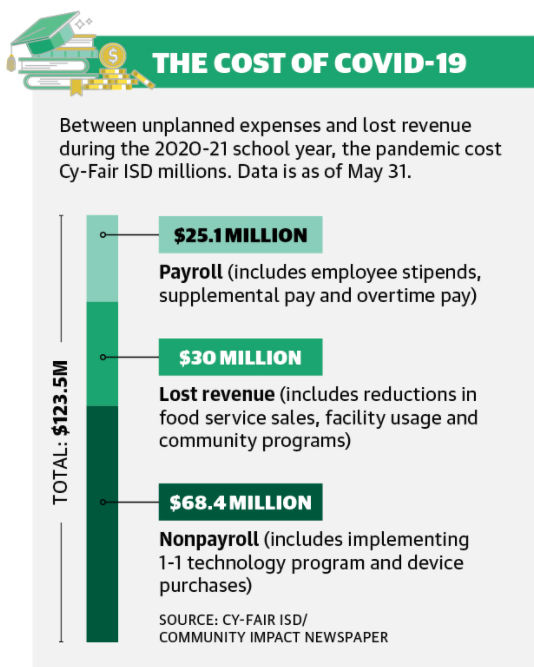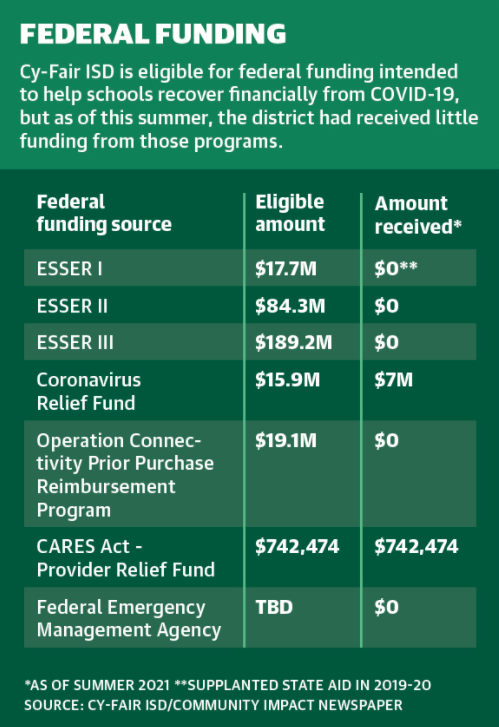 Officials in Cy-Fair ISD are “conservatively” projecting an enrollment of 116,105 students in the 2021-22 school year. While this is slightly more than the 115,798 students enrolled by the end of last school year, it still falls short of prepandemic levels.
Officials in Cy-Fair ISD are “conservatively” projecting an enrollment of 116,105 students in the 2021-22 school year. While this is slightly more than the 115,798 students enrolled by the end of last school year, it still falls short of prepandemic levels.Before the start of the 2020-21 academic year, district leaders estimated an enrollment of nearly 118,500 students, but they saw notable declines in pre-K and kindergarten attendance amid COVID-19.
“It is difficult to determine the exact reasons students did not attend school this year,” Chief Academic Officer Linda Macias said. “Based on prior projections, we saw the most significant decline in pre-K and kindergarten.”
In a typical year, the average daily student attendance in each district determines how much funding the district receives from the state. However, due to a statewide trend, lawmakers agreed not to penalize districts for pandemic-related declines in 2020-21.
This “hold harmless” provision will not carry over to 2021-22, so CFISD leaders are hopeful to see enrollment pick back up. Chief Financial Officer Karen Smith said she anticipates receiving $414.38 million in state revenue for the 2021-22 fiscal year—down from the $436.38 million she projected in the previous budget cycle.
Officials said CFISD launched a “Success Starts Here” campaign in March in an effort to recruit pre-K and kindergarten students back to the district. It included videos, social media, posters, flyers, newspaper advertisements and English and Spanish advertisements on Pandora.
In addition to state funding, federal stimulus money set aside to help schools recover from pandemic-related expenses are on the line.
CFISD is expecting to receive assistance from the Elementary and Secondary School Emergency Relief Fund that could help offset the $88.5 million deficit approved in the 2021-22 budget.
 Smith said the district is eligible to receive up to $189.2 million from the third round of ESSER funding and $84.3 million from the second round. CFISD recently applied for $126 million from the ESSER III grant, and she said the Texas Education Agency will determine how much districts can receive from the ESSER II grant in September.
Smith said the district is eligible to receive up to $189.2 million from the third round of ESSER funding and $84.3 million from the second round. CFISD recently applied for $126 million from the ESSER III grant, and she said the Texas Education Agency will determine how much districts can receive from the ESSER II grant in September. Smith said expenses incurred to respond to COVID-19 and revenue lost during 2020-21 added up to $123.5 million in unexpected costs and lost revenue—such as employee stipends, purchasing enough Chromebooks for each student districtwide to have their own, declines in food service sales and facility usage fees.
ESSER II and ESSER III funding can be used for addressing learning loss, the retention of staff, sanitation supplies, mental health interventions and support, professional development and technology, among other items, according to Smith.
These funds will be used to address learning loss that took place during the pandemic, Macias said.
Campus principals compiled goals for implementing extended learning time; adding staff; offering professional development to help improve student achievement; and acquiring the resources to roll out these goals.
“These learning sessions are staffed by highly qualified teachers equipped with supplies and materials to support their initiatives, which differentiate for children with disabilities, English language learners, children experiencing homelessness, children in foster care, migrant students, children who are incarcerated and other underserved students,” Macias said. “Across the board, students will have additional learning opportunities before and after school, embedded within the school day and offered during summer.”





